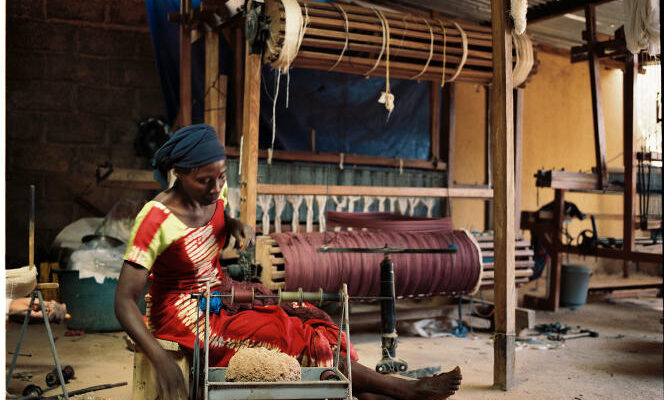Through television, the South African designer Lukhanyo Mdingi grew up in the 1990s with the fantasy of European fashion: skinny and unreal models, demiurge designers à la Gianni Versace… Launched in 2015, the brand that wears its name markets, on the contrary, a dazzling ready-to-wear that promotes the fabrics of the African continent.
Behind some of its textiles, we find the same supplier: Cabes (for Commerce and crafts for social well-being). Lukhanyo Mdingi had heard of this Burkinabe group when he joined the Ethical Fashion Initiative accelerator, an agency of the United Nations and the World Trade Organization supported by the European Union, in 2020.
Founded in 2014 and based in the capital Ouagadougou, Cabes uses only organic cotton and produces fabric from A to Z thanks to its members, “94 textile companies across Burkina Faso, i.e. 2,400 craftsmen, 90% of whom are women”, says its leader, Karfa Yacoro. Often these are “marginalized workers” who are struggling to find a job. Cabes trains them and puts its members in contact with Asian or European labels, such as Camper, Wales Bonner or Loewe.
Dyeing professionals
The structure offers its customers indigo, bogolan, a clay-dyed Malian textile, or even faso dan fani (a thick cotton fabric, typical of Burkina Faso), in which Lukhanyo Mdingi asked to add a Lurex yarn. For his spring-summer 2023 collection, it is above all tie and dye that the 32-year-old designer, who lives between Cape Town and Paris, wanted to explore.
The manufacturing process began in Ouagadougou with delicate stages, “all made by hand”, emphasizes Karfa Yacoro. The threads, made of organic cotton (also grown in Burkina Faso), are first wound on spools, which will be placed in the creel of the loom for warping: here they are unrolled as the threads are fixed on the made flexible, stretched then slowly combed before being knotted.
“Each step is important, explains Zalissa Savadogo, weaver for AZPF, one of Cabes’ member associations. As long as the set-up is not perfect, you have to start over before you can move on to weaving. » The raw canvas then goes to Koudougou, about a hundred kilometers west of the capital, where seven professionals from the Loong Neeré dyeing plant give it colors.
A decisive moment: handmade folding
Lukhanyo Mdingi suggested mixing ocher and brown, but also “a deep navy blue with a very bright orange-yellow”, from which he drew belted dresses or shirts. For this, the fabric, cut into squares of 2 meters, passed through a cleansing bath of hot water and drying in the open air, before being immersed in the first sulfur dye.
Once dry, the square of textile is collected in a kind of crown attached by a thread, then placed flat in a basin on the liquid of the second dye which comes to wash it out from below. A decisive moment: the handmade folding adopted for this crown determines the patterns that will appear on the final fabric – suns, streaks, flows, spectral shapes… “From the first prototype, the colors fell just right”assures Lukhanyo Mdingi.
Newsletter
“Taste of the World”
Travel, fashion, gastronomy, design: the best of the art of living, in your e-mail box
Register
His clothes were then patterned and fitted in South Africa and Italy. And the designer adds that his collaboration with Cabes convinced him that his mission “is not to dictate instructions vertically to manufacturers, but to be as much at their service as they are [s]well, by trying to imagine clothes that must first highlight their fabrics ».
